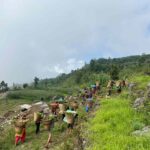
Tick Tock – It’s time to plant trees
June 14, 2024
Birds | Bio indicators of forest restoration progress
December 3, 2024Agroforestry is a land use system where agriculture and forestry disciplines are combined to provide multiple agricultural and forestry products. According to FAO, agroforestry is defined as a dynamic, ecologically based, natural resources management system that, through the integration of trees on farms and in the agricultural landscape, diversifies and sustains production for increased social, economic and environmental benefits for land users at all levels. Agroforestry as a science has emerged almost four decades ago. In context of Nepal, it has been age old practice by farmers. The adoption of agroforestry system has many advantages. It is one of the win- win livelihood opportunity. Agroforestry can be the best alternative to livelihood and it also helps in nature and forest conservation. Planting the fruits and fodder tree in agricultural lands can help increase food production and boost food security and used as forage for livestock. It also helps in health and nutrition improvement. It also helps to create resilient livelihoods of people by reducing the risk of economic failure.
PIN has introduced ten agro sites on seven districts i.e. Jhapa, Chitwan, Nawalpur, Bardiya, Rupandehi, Sindhupalchok and Kaski. Various fruits and fodder species are grown in those agro sites. The fruits such as avocado, guava, lemon, coffee, gooseberry, papaya, mango, litchi, walnut, jackfruit, pomegranate, pear, mulberry, moringa and fodder such as ipil-ipil, chinaberry tree, and mountain ebony are being cultivated in different agro nurseries.
People’s perspectives to agro species distribution
Agroforestry Officers, Mr. Prashnat Raj Giri and Ms. Kabita Mahat visited all the agro sites to conduct orientation and interaction program with local peoples. During the program, they delivered the session about introduction to Plantation Initiative Nepal and importance of agroforestry. Later, the seedling distribution program was conducted in which the nursery agro seedlings were distributed to interested local people. People participation was seen more than expected. More women participation and their interest in the distribution program motivated to expand agroforestry approaches to different parts of Nepal. According to the people, they were happy to be involved in such program and they were also well known about the health benefits of fruits.” Important part of the distribution program was that people prioritized the health benefits rather than economic benefits in the coming future.”, said Ms. Kabita Mahat, Agroforestry Officer.





